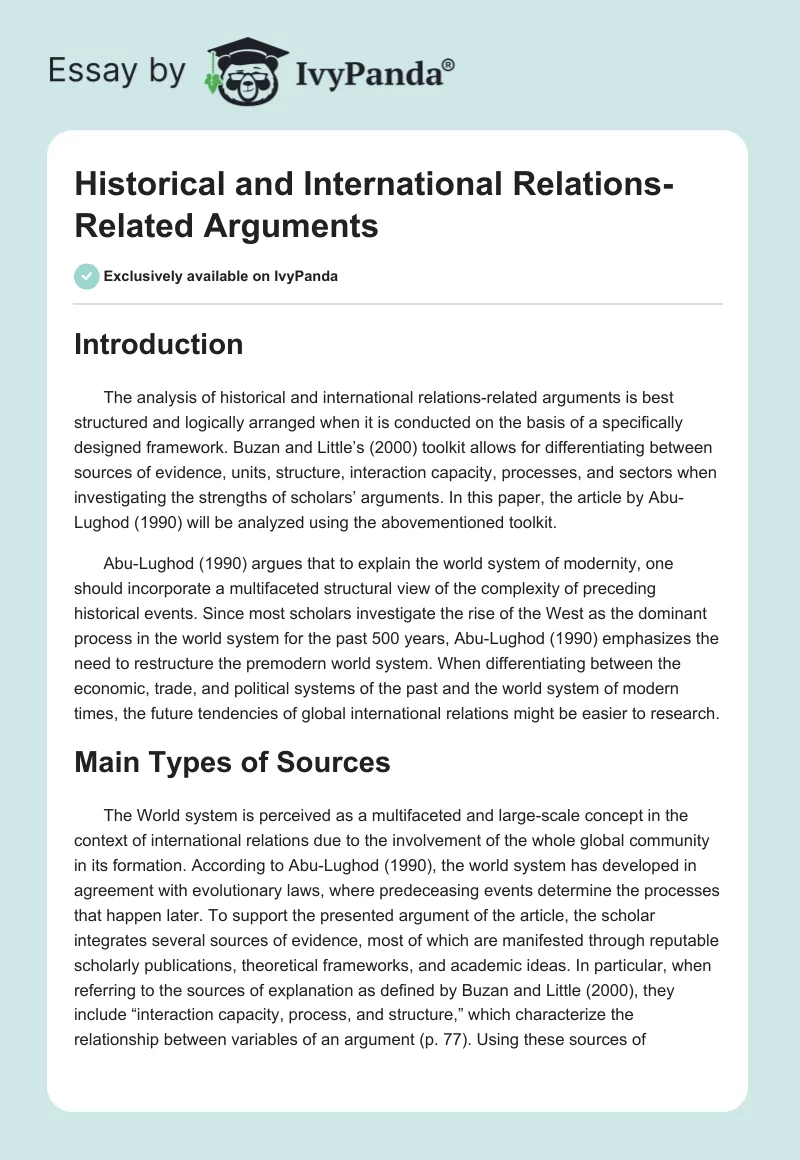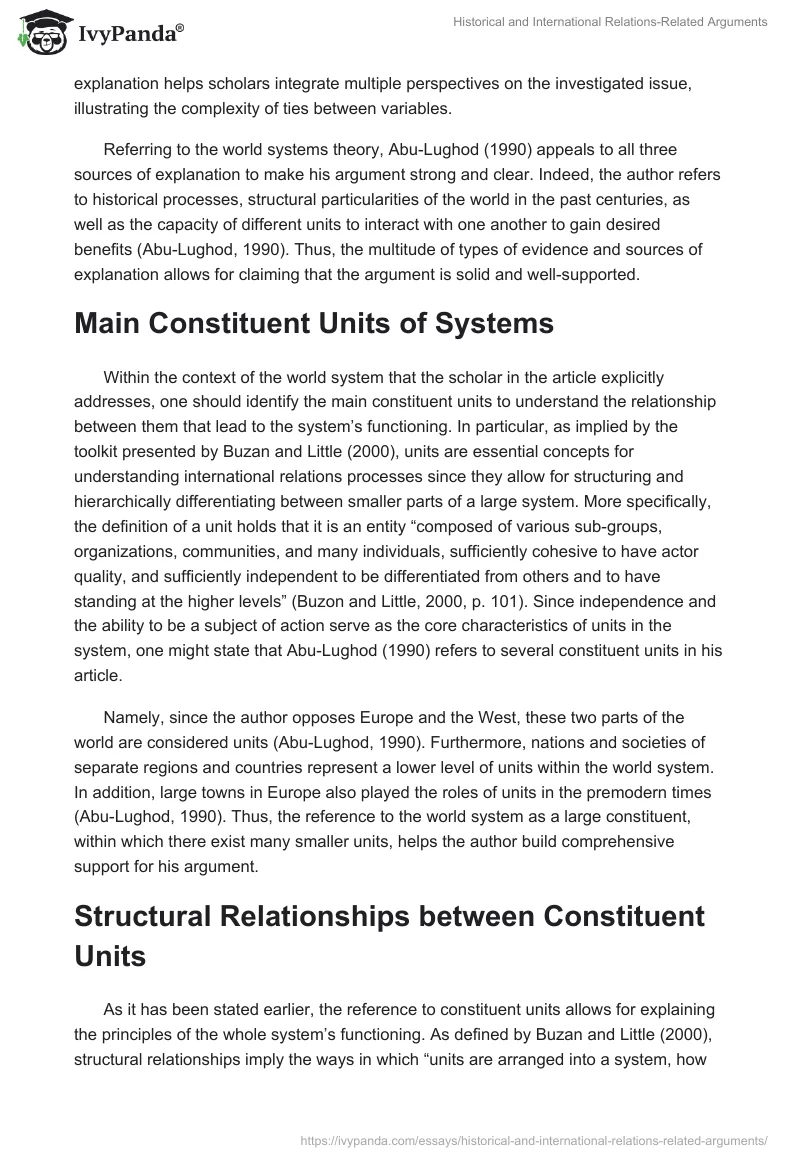Introduction
The analysis of historical and international relations-related arguments is best structured and logically arranged when it is conducted on the basis of a specifically designed framework. Buzan and Little’s (2000) toolkit allows for differentiating between sources of evidence, units, structure, interaction capacity, processes, and sectors when investigating the strengths of scholars’ arguments. In this paper, the article by Abu-Lughod (1990) will be analyzed using the abovementioned toolkit.
Abu-Lughod (1990) argues that to explain the world system of modernity, one should incorporate a multifaceted structural view of the complexity of preceding historical events. Since most scholars investigate the rise of the West as the dominant process in the world system for the past 500 years, Abu-Lughod (1990) emphasizes the need to restructure the premodern world system. When differentiating between the economic, trade, and political systems of the past and the world system of modern times, the future tendencies of global international relations might be easier to research.
Main Types of Sources
The World system is perceived as a multifaceted and large-scale concept in the context of international relations due to the involvement of the whole global community in its formation. According to Abu-Lughod (1990), the world system has developed in agreement with evolutionary laws, where predeceasing events determine the processes that happen later. To support the presented argument of the article, the scholar integrates several sources of evidence, most of which are manifested through reputable scholarly publications, theoretical frameworks, and academic ideas. In particular, when referring to the sources of explanation as defined by Buzan and Little (2000), they include “interaction capacity, process, and structure,” which characterize the relationship between variables of an argument (p. 77). Using these sources of explanation helps scholars integrate multiple perspectives on the investigated issue, illustrating the complexity of ties between variables.
Referring to the world systems theory, Abu-Lughod (1990) appeals to all three sources of explanation to make his argument strong and clear. Indeed, the author refers to historical processes, structural particularities of the world in the past centuries, as well as the capacity of different units to interact with one another to gain desired benefits (Abu-Lughod, 1990). Thus, the multitude of types of evidence and sources of explanation allows for claiming that the argument is solid and well-supported.
Main Constituent Units of Systems
Within the context of the world system that the scholar in the article explicitly addresses, one should identify the main constituent units to understand the relationship between them that lead to the system’s functioning. In particular, as implied by the toolkit presented by Buzan and Little (2000), units are essential concepts for understanding international relations processes since they allow for structuring and hierarchically differentiating between smaller parts of a large system. More specifically, the definition of a unit holds that it is an entity “composed of various sub-groups, organizations, communities, and many individuals, sufficiently cohesive to have actor quality, and sufficiently independent to be differentiated from others and to have standing at the higher levels” (Buzon and Little, 2000, p. 101). Since independence and the ability to be a subject of action serve as the core characteristics of units in the system, one might state that Abu-Lughod (1990) refers to several constituent units in his article.
Namely, since the author opposes Europe and the West, these two parts of the world are considered units (Abu-Lughod, 1990). Furthermore, nations and societies of separate regions and countries represent a lower level of units within the world system. In addition, large towns in Europe also played the roles of units in the premodern times (Abu-Lughod, 1990). Thus, the reference to the world system as a large constituent, within which there exist many smaller units, helps the author build comprehensive support for his argument.
Structural Relationships between Constituent Units
As it has been stated earlier, the reference to constituent units allows for explaining the principles of the whole system’s functioning. As defined by Buzan and Little (2000), structural relationships imply the ways in which “units are arranged into a system, how units are differentiated from each other (p. 84). In the case of Abu-Lughod’s (1990) argument, the structural relationships between Europe and the West since the thirteenth century have changed from the subordination of the former to the latter to equal distribution of power.
Furthermore, the differentiation between units implies that the societies and nations of the world interact on the basis of the nature of relationships between the higher-level units. For example, Abu-Lughod (1990) states that in the thirteenth century, the “world system was organized around three or possibly four cores,” represented by strategically important trade regions (p. 275). Therefore, the societies and nations residing in those regions were hierarchically lower in relation to the regions as constituent units of the world system.
Actors’ Interaction Capacity
The units within the system are regarded as actors who can perform their roles in the interactions. For that matter, the interaction capacity, or the capabilities of units to involve in the relationships and exchanges with other units, relies on the multitude of processes. In particular, one of the most important interactions explicitly referred to in Abu-Lughod’s (1990) article is trade, which involved an exchange of goods between strategically important regions for their proper economic functioning. Furthermore, the interaction capacity involves cultural, political, military, and financial exchanges that characterize the character of relations between the units.
Processes that Formed the Basis for Interaction
The basis for the above-mentioned interactions is formed by specific large-scale processes. According to Buzan and Little (2000), a process is “a product of the dynamics of the interactions among the units in the system and the use made of the existing interaction capacity by these units” (p. 79). Abu-Lughod (1990) both explicitly and implicitly refers to war, the balance of power, alliances, trade competition, and diplomacy as the main processes that enable the interaction between the regions and the nations within the world system. In particular, the author argues that these processes formed the core ground for structuring the world into multi-centered entities, which predetermines the complexity of the modern world system.
Sectors in Article’s Focus
When unfolding the relationships and processes that contribute to the units’ interaction, the author of the analyzed article implicitly emphasizes the decisive role of several specific sectors. Since Abu-Lughod (1990) addresses the evolution of the world system at large, his discussion refers to the authentic sectors, such as social and economic ones, which originated in the premodern times. In addition, the scholar refers to the military-political sector in the context of the distribution of the power of global influence between different regions of the world (Abu-Lughod, 1990). The environmental sector is partially addressed in the context of the impact of local geographical and health-related particularities that changed the interactions between units at different times.
Conclusion
To summarize, the analysis of the article was conducted using the toolkit that helped identify significant elements of the author’s argument. It was revealed that within the world system of the premodern era, Europe, Asia, and the West were large decisive units that cooperated within economic, social, military-political, and environmental sectors. The author uses such sources of explanation as interaction capacity, processes, and structure to argue that the contemporary world order heavily relies on the processes of the past.
Reference List
Buzan, B. and Little, R. (2000) International systems in world history: remaking the study of international relations. New York: Oxford University Press.
Abu-Lughod, J. (1990) ‘Restructuring the premodern world-system’, Review (Fernand Braudel Center),13(2), pp. 273-286.


